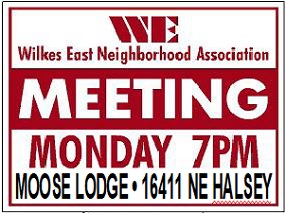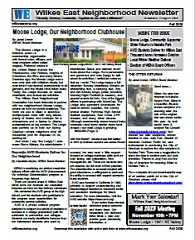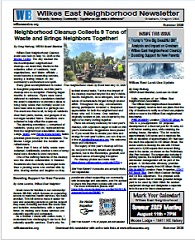
By Janet Unruh, WENA Board Member
Until recently, several dozen homeless campers were living in a forested area northeast of Troutdale on the Sandy River Delta, a.k.a. Thousand Acres Park. The park is about three miles from Gresham and five miles from the Wilkes East neighborhood. It consists of 50 acres of land owned by the Oregon Department of State Lands (DSL), next to 1,500 acres owned by the U.S. Forest Service. The campers have been living on the DSL land[1]. There have been an estimated 35 camps, some of which were in existence for nearly 25 years[2]. DSL states that the land is not suitable for habitation because of wildfire risk, flooding, and environmental degradation[3].
For these reasons, the state attempted a brute-force eviction of the campers in June, but it failed because the campers and their supporters fought back. Another eviction by means of persuasion and facilitation has been underway since then, with a deadline of October 1st to leave voluntarily, after which the remaining campers were to be forced out. There are unanswered questions about where the campers have gone.
THE CAMPS
Campers said they worked to keep their sites clean and used restrooms at nearby parks[4]. They had electricity—the camps had multiple generators and electrical lines that ran from camp to camp[5]. We have meetings—we try to have standards," said Gene, one of the longtime campers. Gene's camp was visibly tidy, complete with decorations and a makeshift fence[1]. However, when the local TV station, KGW, visited the site, most of the camps they saw were not like his[4].
Many living in Thousand Acres describe their community as a family. “This community is a very rare one indeed. It’s a community that’s full of people that come from different walks of life, that in a normal setting would not get along. But one thing that we appreciate the most [about] Thousand Acres is it’s always been a place where we could go and feel like no one is here to judge[4]. Another said, "This is more of a communal existence out here[1].”
The area has multiple memorials for community members who have passed, and gravesites for deceased pets. But in spite of their efforts, trash accumulated and the area became polluted, especially around abandoned camps.
THE INITIAL EVICTION ATTEMPT
Notices were posted in May, stating that campers had to leave by June 2[6]. Campers were to be forced out after the deadline[2]. They hadn’t been offered any help, they said[7].
On June 3, teams from two contract companies hired by DSL, NorthWest HazMat, Inc., and Northwest Enforcement Inc., arrived at Thousand Acres with work crews, trucks, and an excavator. They were blocked at the site by ditches dug across the road to the camps and barriers erected to prevent eviction[1]. A crowd of campers and their supporters had gathered to resist the eviction and cleanup effort. They held up signs that said, “We do not consent” and “Stop the sweep.” As the contractors began attempting to collect the belongings of the campers, a struggle ensued, and witnesses said that four people were maced by the hazmat workers[4]. Oregon Governor Tina Kotek ordered a pause on the eviction due to the repeated clashes[7]. The contractors had been on site for less than a week.
WHAT’S HAPPENING NOW
The Department of State Lands (DSL) reassessed its approach and worked with homeless advocates to determine the best way forward. DSL hired remediation contractor Rapid Response Bio-Clean, which is experienced in trauma-informed engagement and field operations[8].
Multnomah County Homeless Services Department (HSD) contracted with The Salvation Army to conduct outreach to the campers throughout the summer and fall. The outreach team made regular visits to the camps to build trust, share information, and offer connections to shelter and services[3].
"We do anticipate that this current effort will be ongoing for the next several weeks," said DSL spokesperson Alyssa Rash. "Our priority at this time remains voluntary compliance with the people experiencing homelessness or camping overnight at the Delta to relocate. However, we are partnered with law enforcement agencies, and when we have exhausted every avenue toward voluntary compliance, we do have enforcement as a legal backstop option[9]."
The campers responded by submitting a proposal, the “Cooperative Stewardship Proposal for the Sandy River Delta,” which would allow them to continue to live on site and help maintain the space[4].
“This proposal presents a community-driven approach to managing the Sandy River Delta. It emphasizes environmental restoration, responsible habitation, and proactive land management—all aimed at preserving human dignity while safeguarding ecological balance. By integrating sustainable housing solutions with organized land cleanup and long-term cooperative governance, this model stands as a robust alternative to short-term, temporary fixes that have failed many in our community[10].”
The proposal offered solutions for abandoned camps, waste management, hazardous waste, fire safety, enforcement of community rules, unauthorized vehicles, and land restoration. The proposal included a description of the supporting legal and financial framework. The proposal requested modular tiny homes and sustainable infrastructure, with estimated costs of approximately $11,357 – $14,957 per unit. No estimate was given for the number of units. The proposed timeline for phase one called for cleanup and restoration to be completed by August 25. Remaining activities were listed, but without dates.
In conclusion, the proposal offered “a permanent, sustainable solution for the Sandy River Delta. By addressing immediate cleanup needs and combining cost-effective, modular housing with robust community governance, we move beyond the short-term fixes that have repeatedly failed our community. This unified model not only ensures dignified, long-term shelter but also fosters a resilient system of environmental and community stewardship[10].”
The proposal was apparently ignored by DSL. Perhaps the biggest reason would be the risk of flooding. If we ever have another flood like the one in 1996, it would wipe out their village.
THE OCTOBER EVICTION
Some campers had moved out of Thousand Acres by September. On September 15, DSL announced a new, accelerated phase in the eviction and cleanup process. Legal notices were posted at the remaining occupied camps on September 26 informing residents that the area would be closed on October 1st—five days later—and they had to vacate immediately[3].
HSD’s contract with The Salvation Army expires at the end of October, and the outreach team will continue to work with the remaining campers until then. DSL’s contractor, Rapid Response Bio-Clean, will remove personal property and debris from the site, and a (unnamed) security contractor will monitor the area to prevent campers from returning. The area will remain closed for restoration until January 2026[3].
THE OUTCOME FOR CAMPERS
Did East Multnomah County (or the metro area generally) have the capacity to house several dozen homeless people by the October 1st deadline? How many were placed in housing, and how many were forced out to the streets or parts unknown?
I interviewed The Salvation Army Program Manager Phillip Emery about their effort to help the campers transition to shelter. He assured me that they all had access to resources, including the Salvation Army’s own shelters, but he explained that it was out of scope to ensure that everyone was placed. At the end of October, HSD would take that over[11].
The HSD’s data dashboard is a monthly view of data about homelessness in Multnomah County. The most recent demographics as of July, 2025, show 8,278 chronically homeless people in Multnomah County, with 4,467 unsheltered[12].
“I’m on a six-month waiting list for housing, and I don’t know what I’m going to do,” a 20-year Thousand Acres resident known as Grizzly said in the group’s press release. “There’s gotta be some kind of a solution that’s not forcing us out and putting us in jail. That would help nothing[4].”
"There's 40 of us that aren't willing to separate. So as a family, we are going to find a neighborhood somewhere where we can exist at. That may be in somebody's backyard. It may be on their front (expletive) porch," Thousand Acres resident, Countryman said. "I'm not real happy about any of this, but we have to be somewhere[2].
ADDENDUM
I contacted Zach Kearl, Management Analyst at Multnomah County’s Homeless Services Department, to ask him to comment on a draft of the article I wrote on the Thousand Acres homeless camp eviction. He and I have discussed the homeless situation many times over the past months. He kindly wrote back to me in email on October 20, 2025 and told me several interesting things. He gave me his permission to post his response on the WENA newsletter website:
Hi Janet,
Sorry that we missed your deadline of Friday last week. I was out for a good chunk of the week and was playing catch up with the few days that I had.
I have a few notes to offer up after reading your article:
The attempted campsite removal in June was paused in large part because of issues with DSL's contracted provider doing the clean up and insufficient planning to manage protests. The significant differences this go around were that DSL coordinated with Oregon State Police to provide crowd management and assist in trespassing, as well as contracting with a more experienced campsite removal org used by City of Portland and ODOT. In both instances, there were considerable attempts at connecting individuals living in Thousand Acres to services and available shelter or housing.
Many of the folks who were living in Thousand Acres are not interested in shelter or conventional housing. Some have aspirations of creating a commune and have since tried to relocate to other undeveloped land in the surrounding areas to do so, including USFS and ODOT properties. Sustained enforcement across the multi-jurisdictional areas are being planned.
The planned posting for October removal was communicated with residents of Thousand Acres up to a month in advance, with The Salvation Army outreach team and Rapid Response Bioclean visiting campsites and talking with residents on a daily basis. The official posting was merely an obligatory legal step prior to being able to proceed with enforcement.
At the last update from DSL and Rapid Response I attended (last week), teams reported that after some attempts to resettle after the initial enforcement, DSL has successfully closed the Thousand Acres area and Rapid Response is underway removing material as planned. Personal possessions are being stored for up to a month, per Oregon Revised Statute (ORS), and will be returned to property owners if requested.
There were about a half dozen individuals who accepted a shelter bed around the week of enforcement. Those that did, ended up in one of the region's alternative, village-style shelters.
Outreach teams have sought to enter folks into HMIS to support case management; however, individuals are not compelled to provide the requisite information if they are not accepting services.
I'll also share that the resident you quoted, Grizzly, was housed a couple years out of Thousand Acres. I had a chance to talk with him this Spring when I went out there. Unfortunately, he returned to homelessness. What he shared with me was that there were interpersonal challenges with the property manager and dissonance in being in a more urban/sedentary environment--just a microcosm of the obstacles that can occur when trying to end homelessness for folks who have lived outside for years and decades.
Sincerely,
Zach
Zach Kearl (he/him), MPA
Management Analyst
Homeless Services Department
Multnomah County | Gladys McCoy Building
619 NW 6th Avenue, Portland, OR 97209
Click "Read more" (below) to view Endnotes

































